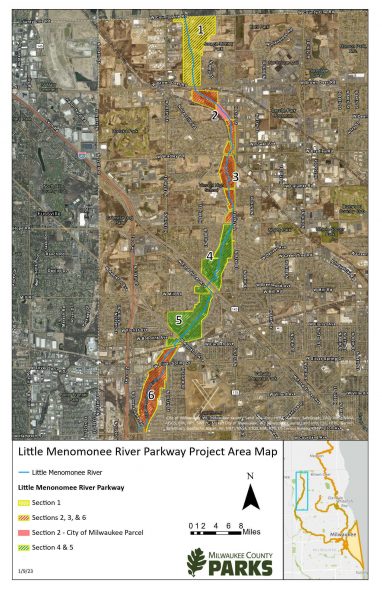Parks Restoring Wildlife Habitat in Little Menomonee River Parkway
$3 milllion grant from DNR will fund another restoration in Milwaukee Estuary.

Project map. Milwaukee County Parks.
Milwaukee County Parks is in line to receive $3 million from the state for a habitat restoration project in the Little Menomonee River Parkway.
The project is focused on rehabilitating fish and wildlife habitats along the river on the western edge of the county and the funding comes from the state Department of Natural Resources. The funds will cover work along the river, running north to south, between approximately W. County Line Rd. and W. Hampton Ave. and west of 98th St. on the far Northwest Side of Milwaukee.
The project is part of the department’s larger contribution to delisting the Milwaukee Estuary as an Area of Concern (AOC). The estuary received the designation in 1987 for pollution and environmental degradation. Restoring plant and wildlife habitats along the Little Menomonee River Parkway is one of the many projects across the county being undertaken to remediate the conditions that led to the designation.
The project was identified in 2015 as “a necessary fish and wildlife restoration project,” said Erica Goblet, Parks contracts manager. The project area is broken up into a number of sections based on work that has been completed to date. Habitat restoration is already underway in some areas, while a restoration plan still needs to be developed in others.
This area is what the Southeastern Wisconsin Regional Planning Commission calls a “primary environmental corridor.” This means it is an “elongated” area with “concentrations of the best remaining elements of the natural resource base, including wetlands, woodlands, surface-water areas and associated undeveloped shorelands and floodplains, and wildlife habitat areas.”
The aquatic habitats along the corridor have been similarly degraded by “historic draining and filling of wetlands, channelization of the riverbed, rapid stormwater run-off from impervious urban surfaces, and declining water quality from agriculture in the upper watershed.”
The DNR has informed Parks that the $3 million grant could be finalized by October. Parks is hoping to have the project completed by the end of 2026.
If you think stories like this are important, become a member of Urban Milwaukee and help support real, independent journalism. Plus you get some cool added benefits.
More about the Area of Concern Abatement Effort
- New Machine Quietly Cleans Milwaukee’s Water - Jeramey Jannene - Mar 21st, 2025
- Photo Gallery: New South Shore Park Beach Takes Shape - Graham Kilmer - Mar 14th, 2025
- MKE County: Effort Aims To Reduce E. Coli Closures at Bradford Beach - Graham Kilmer - Feb 27th, 2025
- MKE County: Habitat Restoration Planned in Kletzsch Park - Graham Kilmer - Feb 14th, 2025
- MKE County: County Deploying $1.3 Million in Environmental Cleanup Grants - Graham Kilmer - Sep 19th, 2024
- MKE County: Habitat Restoration Coming to Kohl Park - Graham Kilmer - Jan 12th, 2024
- MKE County: Largest Fish Barrier Between Grafton and Lake Michigan Removed - Graham Kilmer - Dec 21st, 2023
- EPA Giving Milwaukee $17 Million For Sewer Project - Evan Casey - Nov 2nd, 2023
- Cleanup Of Polluted Great Lakes Sites Reverses Housing Price Declines - Danielle Kaeding - Oct 19th, 2023
- Milwaukee Wins $275 Million Grant To Fund Massive Waterway Cleanup - Jeramey Jannene - Oct 12th, 2023
Read more about Area of Concern Abatement Effort here
MKE County
-
RNC Will Cause Some County Services To Be Moved to Wauwatosa
 Jul 12th, 2024 by Graham Kilmer
Jul 12th, 2024 by Graham Kilmer
-
Hank Aaron State Trail Will Be Closed For RNC, State Fair
 Jul 12th, 2024 by Graham Kilmer
Jul 12th, 2024 by Graham Kilmer
-
MCTS Designing New Bus Shelters
 Jul 10th, 2024 by Graham Kilmer
Jul 10th, 2024 by Graham Kilmer




















